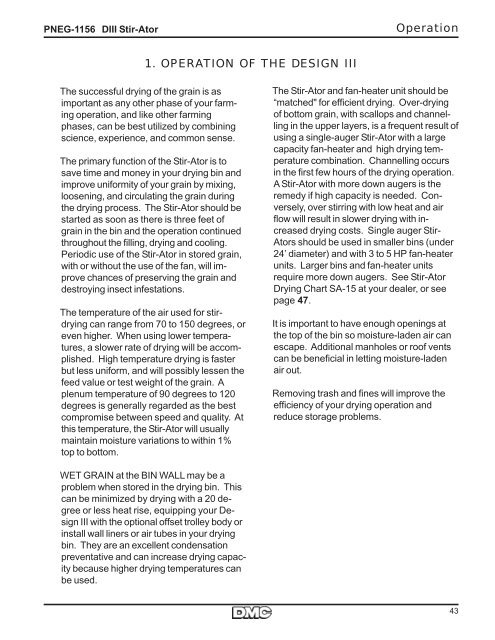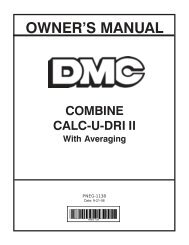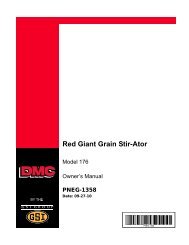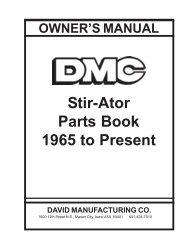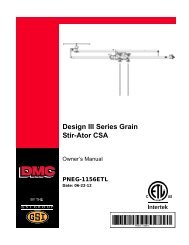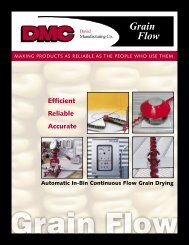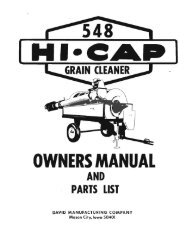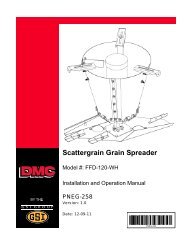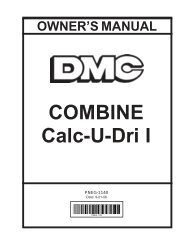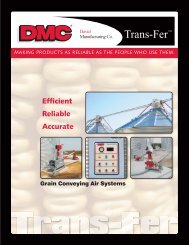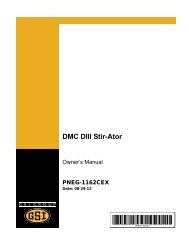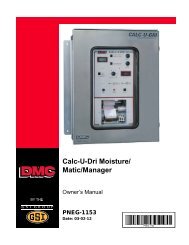GRAIN STIR-ATOR - David Manufacturing Co.
GRAIN STIR-ATOR - David Manufacturing Co.
GRAIN STIR-ATOR - David Manufacturing Co.
Create successful ePaper yourself
Turn your PDF publications into a flip-book with our unique Google optimized e-Paper software.
PNEG-1156 DIII Stir-Ator<br />
Operation<br />
1. OPERATION OF THE DESIGN III<br />
The successful drying of the grain is as<br />
important as any other phase of your farming<br />
operation, and like other farming<br />
phases, can be best utilized by combining<br />
science, experience, and common sense.<br />
The primary function of the Stir-Ator is to<br />
save time and money in your drying bin and<br />
improve uniformity of your grain by mixing,<br />
loosening, and circulating the grain during<br />
the drying process. The Stir-Ator should be<br />
started as soon as there is three feet of<br />
grain in the bin and the operation continued<br />
throughout the filling, drying and cooling.<br />
Periodic use of the Stir-Ator in stored grain,<br />
with or without the use of the fan, will improve<br />
chances of preserving the grain and<br />
destroying insect infestations.<br />
The temperature of the air used for stirdrying<br />
can range from 70 to 150 degrees, or<br />
even higher. When using lower temperatures,<br />
a slower rate of drying will be accomplished.<br />
High temperature drying is faster<br />
but less uniform, and will possibly lessen the<br />
feed value or test weight of the grain. A<br />
plenum temperature of 90 degrees to 120<br />
degrees is generally regarded as the best<br />
compromise between speed and quality. At<br />
this temperature, the Stir-Ator will usually<br />
maintain moisture variations to within 1%<br />
top to bottom.<br />
The Stir-Ator and fan-heater unit should be<br />
“matched" for efficient drying. Over-drying<br />
of bottom grain, with scallops and channelling<br />
in the upper layers, is a frequent result of<br />
using a single-auger Stir-Ator with a large<br />
capacity fan-heater and high drying temperature<br />
combination. Channelling occurs<br />
in the first few hours of the drying operation.<br />
A Stir-Ator with more down augers is the<br />
remedy if high capacity is needed. <strong>Co</strong>nversely,<br />
over stirring with low heat and air<br />
flow will result in slower drying with increased<br />
drying costs. Single auger Stir-<br />
Ators should be used in smaller bins (under<br />
24’ diameter) and with 3 to 5 HP fan-heater<br />
units. Larger bins and fan-heater units<br />
require more down augers. See Stir-Ator<br />
Drying Chart SA-15 at your dealer, or see<br />
page 47.<br />
It is important to have enough openings at<br />
the top of the bin so moisture-laden air can<br />
escape. Additional manholes or roof vents<br />
can be beneficial in letting moisture-laden<br />
air out.<br />
Removing trash and fines will improve the<br />
efficiency of your drying operation and<br />
reduce storage problems.<br />
WET <strong>GRAIN</strong> at the BIN WALL may be a<br />
problem when stored in the drying bin. This<br />
can be minimized by drying with a 20 degree<br />
or less heat rise, equipping your Design<br />
III with the optional offset trolley body or<br />
install wall liners or air tubes in your drying<br />
bin. They are an excellent condensation<br />
preventative and can increase drying capacity<br />
because higher drying temperatures can<br />
be used.<br />
43


